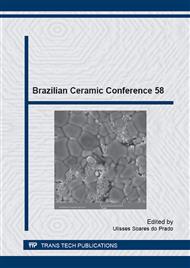[1]
H. H. Murray: Dev. Clay Sci. Vol. 2 (2007), p.180.
Google Scholar
[2]
A.F.D.C. Varajão, B. Boulangé, A.J. Melfi: Rev. Bras. de Geociências Vol. 20 (1990), p.75.
Google Scholar
[3]
A.F.D.C. Varajão, R.J. Gilkes, R.D. Hart: Clay. and Cl. Min. Vol. 49 (2001), p.44.
Google Scholar
[4]
M.C. Santos: Caracterização dos depósitos argilosos da porção centro-sul do Sinclinal Moeda, Quadrilátero Ferrífero, MG: macromorfologia, micromorfologia, cristaloquímica, gênese e considerações industriais. Mestrado (Dissertação). Ouro Preto, 2003. Universidade Federal de Ouro Preto (UFOP). (MG).
DOI: 10.17143/ciaed/xxiilciaed.2017.00316
Google Scholar
[5]
M.C. Santos, A.F.D.C. Varajão, J. Yvon: Catena Vol. 55 (2004), p.277.
Google Scholar
[6]
A.M.M. Carrera, M.G. Peralta-Sánchez, A.F.D.C. Varajão, M.M. Ferreira: Téc. Aplic. a la caracterización y aprovechamiento de recursos geológico-mineros: Descripciones Metodológicas. Inst. Geo. y Min. de España, Oviedo Vol. 1 (2010), p.160.
Google Scholar
[7]
M.G. Peralta-Sánchez, A.M. Morales-Carrera, A.F.D.C. Varajão, M.M. Ferreira: Cer. Vol. 57 (2011), p.254.
Google Scholar
[8]
M.M. Ferreira, A.F.D.C. Varajão, A.M. M. Carrera, M.G.P. Sánchez, G.M. Costa: Cer. Vol. 58 (2012), p.105.
Google Scholar
[9]
A.F.D.C. Varajão, M.C. Santos, A.M.M. Carrera, M.G.P. Sánchez, C.C.G. Silva: 57º Congresso Brasileiro de Cerâmica (CBC). 5° Congresso Iberoamericano de Cerâmica. Natal 19 - 22 de Maio, 2013. Proceeding.. Natal, 2013. (RN).
Google Scholar
[10]
ISO – International Organization for Standardization. ISO13006. Ceramic tiles: Definitions, classification, characteristics and marking. Geneve. (1998) 56p.
Google Scholar
[11]
H.S.S. Torres: Caracterização do refugo do esteatito das indústrias e oficinas artesanais da região de Congonhas, Conselheiro Lafaiete, Mariana e Ouro Preto. Dissertação Mestrado (Dissertação). Ouro Preto, 2007. Rede Temática em Engenharia de Materiais (REDEMAT/ UFOP). (MG).
DOI: 10.25145/j.pasos.2023.21.039
Google Scholar
[12]
Associassão Brasileira de Normas Técnicas. Tijolo maciço cerâmico para alvenaria. Rio de Janeiro: ABNT 1983. (NBR 7170).
Google Scholar
[13]
H.S.S. Torres, A F D.C. Varajao, A.C.S. Sabioni:. Technological characterization of ceramic produced from soapstone residues and kaolin. Applied Clay Science (2014).
DOI: 10.1016/j.clay.2015.04.016
Google Scholar
[14]
Associação Brasileira de Normas Técnicas. Componentes cerâmicos P. 3: Blocos cerâmicos para alvenaria estrutural e de vedação – Métodos de ensaio. Rio de Janeiro: ABNT 2005. (NBR 15270-3).
DOI: 10.22410/issn.2176-3070.v10i4a2018.2009
Google Scholar
[15]
L.A. Gaspar Júnior: Adição experimental de novos materiais às argilas da região do polo cerâmico de Santa Gertrudes (SP). Tese (Doutorado em Geociências). Departamento de Petrologia e Metalogenia. Universidade Estadual Paulista. (2003).
DOI: 10.22456/1807-9806.35816
Google Scholar
[16]
Associação Brasileira de Normas Técnicas. Placas cerâmicas para revestimentos – Especificação e métodos de ensaio. Rio de Janeiro: ABNT 1997. (NBR 13818).
Google Scholar
[17]
ASTM International. C1161-90. Standard Test Method for Flexural Strength of Advanced Ceramics at Ambient Temperature. (1990) 19pp.
Google Scholar
[18]
M. Wesolowski: Therm. Acta. Vol. 78 (1984), p.395.
Google Scholar
[19]
B. Reynard, J.D. Bass, J.M. Jackson: Journal of the European Ceramic. Soc. Vol. 28 (2008), p.2459.
Google Scholar
[20]
B.M. Kim, Y.K. Cho, R. Stevens, H.C. Park: Ceram. Int. Vol. 35 (2009), p.597.
Google Scholar
[21]
J.J. Meléndez-Martínez, M. Jiménez-Melendo, A. Domínguez-Rodriguez, G. Wötting, Journal of the Europe Ceram. Soc. Vol. 21 (2001), p.63.
Google Scholar
[22]
Z. Acimovic, L. Pavlovic, L. Andric, M. Stamotovic: Mat. Let. Vol. 57 (2003), p.26516.
Google Scholar


